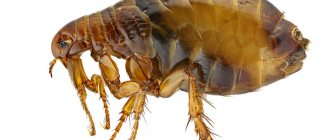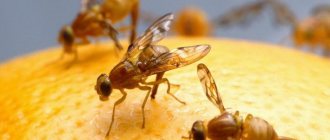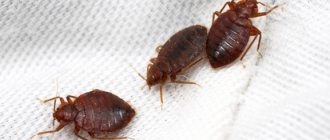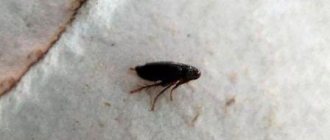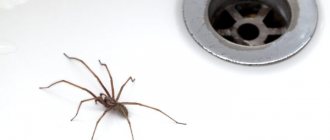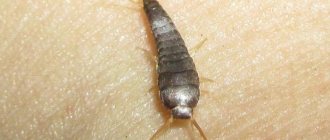Bed lice, like head lice, belong to the order of ectoparasites that live off humans. During its evolution, the linen louse has adapted to living not in hair, but in the folds of clothing. Despite the fact that linen lice do not exist on the body continuously, their presence causes discomfort and causes other problems.
Getting rid of linen lice is difficult, because insects quickly adapt to different living conditions.
How dangerous are these parasites?
When this type of lice is detected, a diagnosis of body lice is made. The linen louse feeds on blood and, despite its miniature size, poses a health threat. Through their bites and waste products you can become infected:
- typhus;
- Volyn (trench) fever;
- relapsing louse typhus.
Infectious agents enter the bloodstream through parasite bites.
In addition, bites are dangerous because the linen louse secretes special saliva, which can cause allergic reactions.
It causes severe itching, which causes scratching and there is a risk of secondary infection. With extensive damage, the nervous system suffers - patients become emotionally unstable and complain of insomnia.
General description of body lice.
Treating Bites
To avoid infection of wounds and relieve itching from lice bites, it is necessary to treat damaged skin:
- The body is washed with soap - laundry, tar or other antibacterial.
- The bite sites are cauterized with an alcohol-containing solution - calendula, cologne, vodka.
- To eliminate severe itching - antihistamine, bactericidal external agents - Fenistil, Psilo-balm, Menovazin, Zvezdochka.
- For allergic reactions, glucocorticosteroids are additionally prescribed - Sinaflan, Flucinar.
Treatment is prescribed by a doctor; you need to contact her immediately to avoid infection and the development of allergies.
Causes of appearance and routes of infection
Linen lice are also called bed or clothing lice because they live on textile surfaces. They cannot jump like fleas, but they can crawl short distances.
The main reasons for the appearance and routes of infection are unsanitary conditions (dirt, lack of washing), however, under certain conditions, lice can enter a clean house.
You can become infected in the following ways:
- By clinging closely to an infected person (in transport, in a queue, etc.).
- Having visited public places where hygiene standards are not observed - bathhouse, sauna, swimming pool, gym.
- In hostels, hospitals, sanatoriums, rented apartments, children's camps.
- After trying on or buying clothes at markets, second-hand stores, and consignment stores.
- When working with disadvantaged segments of the population - the homeless, people leading an antisocial lifestyle.
How do linen lice differ from other parasitic insects that plague humans?
Distinctive signs of lice from fleas: light coloring, inability to jump.
Unlike bedbugs, lice are smaller and lighter in color. Bedbugs bite only at night, lice bite whenever they want, the main thing is that the person is dressed. Lice differ from ticks by being lighter in color and living in groups. A tick has 8 legs, a louse has 6.
You can hardly tell a body louse from a head louse, they are very similar. The pubic louse looks like a small crab. Diseases carried by linen lice
Linen lice are the most insidious and dangerous in terms of infecting humans with various diseases. The reason is very obvious - linen lice are very common in people who lead an unsanitary lifestyle. In addition to body lice, such people often have other diseases. Linen lice bites are dangerous:
- The appearance of unpleasant itching;
- Allergic rashes all over the body;
- Irritability in children;
- Ulcers;
- Pyoderma;
- Scratching leads to the development of infections.
It is not uncommon for body lice to carry the pathogens of typhus, relapsing fever, and Volyn fever.
Description of body lice
Insects live and breed on linen items that are in close contact with the human body; it is impossible to become infected from animals. The linen louse is a form of lice that arose thousands of years ago in connection with the spread of clothing.
Appearance
The linen louse has an external resemblance to the subspecies that lives in hair. A description of body lice will help you quickly recognize the blood-sucking parasite:
Diagnostic signs of linen lice.
- The body is elongated, fusiform, translucent, 3-4 mm long.
- There are no wings, it moves with the help of three pairs of paws with tenacious claws.
- The abdomen is light, almost white. After saturation with blood, it appears reddish or brownish.
- The oral apparatus is of the piercing-sucking type, designed to feed on blood.
- There are no eyes; they orient themselves in space using olfactory receptors located on their antennae.
Linen lice do not live alone; when infected, they quickly form numerous colonies. Upon examination, the first thing that catches your eye is the bites, after which it makes sense to look for insects.
Life activity
Bed lice need human blood to thrive. To do this, 3-4 times a day they crawl onto the body, pierce the skin, sucking out up to 5 µl at a time. When a linen louse bites, it secretes saliva containing enzymes that prevent blood clotting. These enzymes cause specific reactions on the skin: pain, irritation, allergies.
The lifespan of one individual is on average 38 days. Every day, a linen louse lays 12-15 eggs (nits), which amounts to several hundred over the entire period. The embryo turns into an adult sexually mature louse in 5-7 days. If apartment types of bedbugs are active at night, then the linen louse also bites during daylight hours.
They actively reproduce in warm conditions (+31…+32ºC), withstand temperature fluctuations from 0º to +40ºC. At moderate temperatures (+10...+20º C), linen louse survives without food for up to 1.5 weeks, nits - much longer. They die when heated above +44ºC.
Body louse development cycle.
Where to look
Clothes lice never crawl far from their food source; most often they form colonies on underwear and bedding. They don't like open spaces, so it's worth looking for them:
- at the seams;
- in folds and ruffles;
- under the collar;
- in cuffs and pockets.
The linen louse takes root best on woolen and cotton fabrics; nits are deposited on the pile or in places hidden from view. The linen louse is reluctant to settle on silk and satin items because it slides off the smooth fibers.
Linen louse: appearance and physiology
Body lice are small wingless insects with an elongated abdomen and a body length of 2 to 3 millimeters. If you look closely, the edges of the abdomen have a small folded border. These folds form when the louse's stomach is empty.
Under such circumstances, the abdomen contracts, causing it to shrink. A distinctive feature of linen lice compared to other species is their light, transparent white abdomen. After drinking blood, the louse turns red or brown. Larvae (nymphs) differ from adults only in size - they are smaller. The nits are identical to those of head lice.
The female body louse usually deposits nits in seams, folds and folds of clothing, as well as in pockets.
More often than not, this will be a place where it is difficult for a person to reach. It is impossible to detect a nit without magnification - its size is 0.5 mm. Lice on clothing can be identified by the fact that these insects tend to stick together in groups of several individuals.
How to get rid of linen lice at home
You can destroy linen lice in your home without involving special sanitary services. This will require an integrated approach: simultaneous treatment of the body, clothing, bedding, upholstered furniture and carpets.
First of all, you should take a hot shower and wash your skin with laundry soap, since linen louse cannot tolerate an alkaline environment.
Before removing linen lice at home, be sure to inspect your head - bed insects often coexist with head lice. In this case, hair treatment will be required.
The fight against linen lice involves special treatment of all items affected by insects.
To kill harmful insects at home, you can use the following methods:
- Chemical treatment of bedding and clothing. This is the most reliable method, which involves the use of synthetic insecticides. The advantages of this method are reliability, speed, and ease of use. Disadvantage - cannot be used during pregnancy, as well as for treating the beds of children under 3 years of age and those with allergies.
- Heat treatment. Boiling is a reliable but labor-intensive method that is suitable for clothing and sleeping sets, but not suitable for upholstered furniture. Good results can be achieved by using a household steam generator, but you need to steam things slowly and from all sides.
- Folk methods of struggle. Since such methods involve the use of alkalis, kerosene, and extracts of potent plants, they must be used with caution.
For people with hypersensitivity and a tendency to allergic reactions, the freezing method can be recommended. To do this, put linen and clothes in the freezer for a period of 3 to 7 days, setting the lowest temperature. Then they are washed and ironed with the steam function.
If there is a massive infestation of linen lice, it is better to throw away most things.
Treatment of bedding and clothing
It is recommended to take wardrobe items that cannot be washed to a dry cleaner, where they will be processed in a disinfection chamber. To completely eliminate body lice, you will have to treat not only bedding and all clothing, but also mattresses, carpets, blankets, and bed frames.
Modern preparations based on synthetic insecticides will help you quickly get rid of insects hidden in secluded places:
Efficiency and action of the drug Medifox.
- "Medifox" - contains permethrin, is available in the form of a gel and a concentrate for the preparation of an emulsion. Infected beds and things are soaked for 40 minutes in a 0.2% solution, then soaked in diluted soda and washed. Non-washable items and sleeping areas are sprayed with this solution, dried and ventilated.
- “Para Plus” is a fast-acting aerosol, in addition to permethrin, it contains two more active insecticides, so it has a detrimental effect not only on lice, but also on nits. The long thin nozzle of the sprayer allows you to treat hard-to-reach places: joints of upholstered furniture, crevices, deep narrow pockets. Leaves no traces or odor, action time is 10 minutes.
- “Permethrin” is a budget drug, available in the form of a solution or aerosol. The solution is used for soaking laundry, the aerosol is used for surface treatment of furniture. Effective after 40 minutes, after which bedding and clothes are washed with thorough rinsing.
When using aerosol insecticides, the treated items are wrapped in plastic bags - this way the active substances and their vapors will penetrate deeper between the fibers and act more effectively. The eggs of parasites are covered with a durable shell that is resistant to aggressive influences, so after 10-14 days the treatment must be repeated.
Bedding and wardrobe items must be ironed with a hot iron after washing. After treatment, the room is ventilated, cutlery and kitchen surfaces are washed with soapy water and soap.
Prevention measures
To prevent the appearance of linen lice in your apartment, you need to follow simple rules, such as:
- regular cleaning of the apartment;
- cleaning dust from upholstered furniture and carpets;
- weekly change of bed linen;
- periodic washing or dry cleaning of blankets, pillows, blankets;
- keeping the body clean and changing underwear daily.
Linen lice quickly occupy new territory, so measures to eliminate them must be started immediately as soon as the parasites are discovered. And, of course, follow preventive measures, because preventing the appearance of insects is much easier than later dealing with the invasion of blood-sucking parasites.
Folk methods of struggle
Some plants contain components that have an insecticidal and repellent effect. For prevention, dried or fresh herbs are taken and laid out in bunches in cabinets. For destruction, strong decoctions, extracts, and extracts added during washing are used.
Linen lice can be killed using various herbs.
Active substances that are harmful to linen lice are:
- wormwood;
- field milkweed;
- tansy;
- larkspur;
- hellebores.
Linen louse cannot tolerate the aroma of lavender and tea tree, so the essential oils of these plants are added to the water for washing contaminated items.
In the past, kerosene and soda ash solution were used to soak laundry. These products have a detrimental effect on lice, but today they are not used due to their health hazards.
Preventive measures
The main measure to prevent the appearance of bed lice is keeping your clothes, sleeping area and entire home clean.
The following recommendations will help reduce the risk of parasite infection:
- When traveling, wear clothes with smooth synthetic or silk fibers.
- If you are forced to stay in unsanitary conditions, use prophylactic products based on essential oils.
- Wash pillows, blankets, blankets or take them to the dry cleaner.
- Keep bed linen dry and fresh; damp linen should be washed again and dried well.
- Carpets, especially natural ones, as well as upholstered furniture, should be regularly vacuumed and treated with insecticidal compounds.
- Observe personal hygiene rules and do not use other people's things.
Always wash newly purchased clothes, no matter where they were purchased - at a garage sale, second-hand store or boutique.
Life cycle
This parasite goes through several stages in its development:
- nit – an egg in which a larva develops; development occurs within 5–8 days;
- nymph of the first, second and third order - the larva emerges from the egg and goes through three molts, increasing in size; this stage usually takes from 16 to 21 days;
- imago - an adult individual.
Body lice begin to bite and drink blood already at the nymph stage, but only adult insects can mate and reproduce. The female lays an average of 4 eggs per day. Over the course of its life, it lays more than a hundred nits, so lice must be dealt with immediately after detection in order to prevent a sharp increase in the population. There are also particularly fertile individuals that can lay up to 300 eggs in their lifetime.
